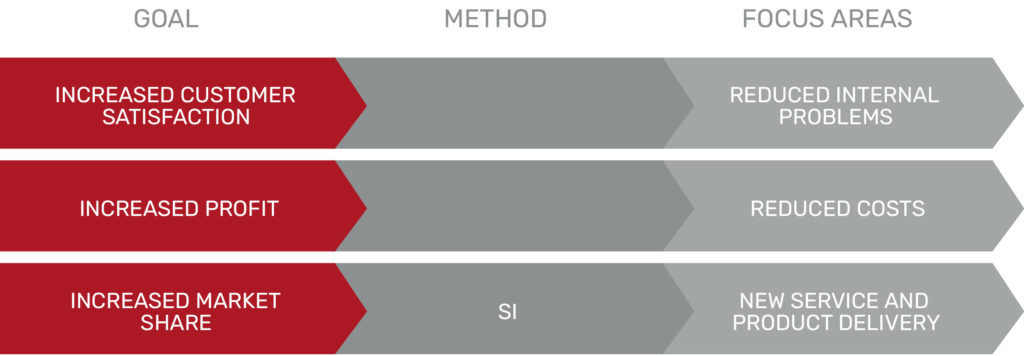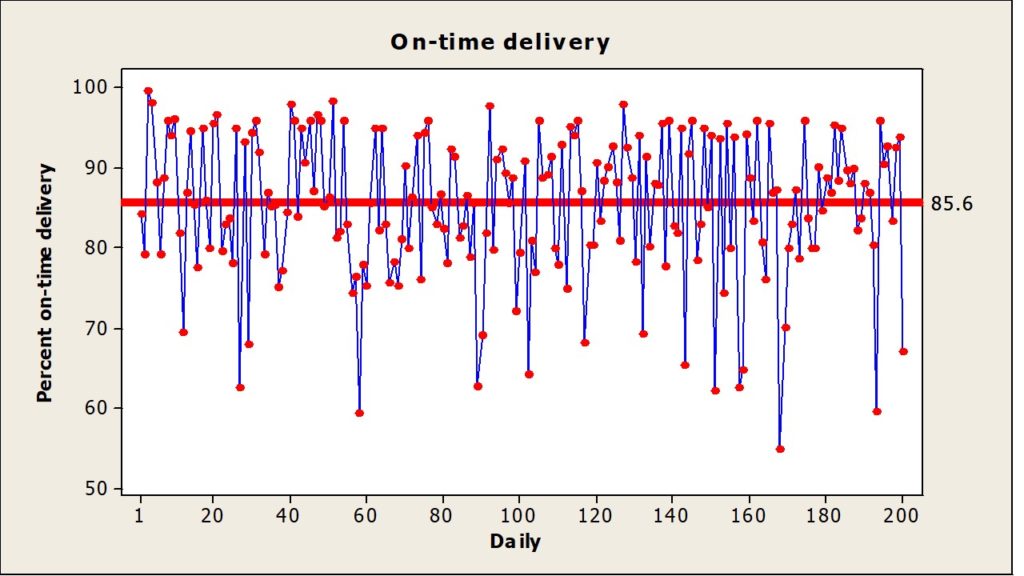SECORA WHITE PAPER: PREVENTATIVE BUSINESS HEALTHCARE
Chapter 1
To stay competitive in a fast-moving market, many companies are working hard to increase customer satisfaction, gain market share, and at the same time remain profitable.
Many industries focus their efforts only in one area (mostly the profit side), hoping that the other two areas (market growth and customer satisfaction) will automatically follow.
This is simply not the case. However, if one focus area declines, the others will certainly follow.
Another mistake is to tie all three focus areas into a single overall strategy. By doing so, companies ignore the fact that each focus area has its own dynamics, requirements, and priorities. Using this approach will only waste valuable resources, time, and efforts.
To survive in today’s market we have to focus on all three area separately. One cannot function without the other.

KISS 1 (Keeping It Simple Statement)
- If your customer satisfaction levels are high, but it costs you too much, and you don’t gain market share, you’ll eventually die.
- If you only focus on profit, without considering customer satisfaction or new services/products for the future, you’ll eventually die.
- If you invest all your time in new service and product developments, but forget customer satisfaction and profit, you’ll eventually die.

The ABCs of Preventative Business Healthcare
Preventive Business Health (PBH) can be explained in very simple terms, by comparing a company’s health to human health.
What are the three basic elements a human needs to survive?
Airway -Without a proper airway we’ll die
Breathing – Without oxygen to breathe, we’ll die
Circulation – With poor, meagre or no circulation, we’ll die
All EMTs (Emergency Medical Technicians) and doctors know the ABCs of maintaining life.
First step: Evaluate the airway.
A = Airway. Establish and maintain a proper airway. Without, or with an insufficient, airway passage we cannot survive.
Second step: Establish regular breathing.
B = Breathing/Oxygen. Restore and maintain healthy breathing. A person can survive without oxygen for a while depending on how extreme the oxygen loss is.
Third step: Maintain circulation
C = Circulation. Assess the presence or absence of circulation. Unstable, bad, or poor circulation hastens death.
The airway allows us to breath and our breathing is the basis for circulation. Airway, breathing, and circulation are vital for life, and each is required, in that order, for the next to be effective.
What three basic elements does a business need to have to survive?
Customer Satisfaction – Without real customer satisfaction, your business will fail.
Profit – Without making a profit, your business will fail.
Market Share – With poor, meagre or no market share, your company will fail.
Just as all EMTs and doctors know the ABC’s of maintaining life, so should business leaders know the ABCs of business health for survival and prosperity:
First step: Evaluate your customer satisfaction.
A = Customer Satisfaction. Establish and maintain strong customer satisfaction. A business cannot survive with low customer satisfaction levels.
Second step: Establish regular profit.
B = Profit. Restore and maintain healthy profit. A business can survive without profit for a while depending on how extreme the overheads are.
Third step: Maintain market share and growth.
C = Market Share/Growth. Assessing the presence or absence of market share/growth. Companies with unstable or poor market share/growth will eventually close.
Closing the loop:
Customer satisfaction is the basis for companies to be in business. Being in business allows companies to generate a profit. Profit allows companies to maintain and grow in market share. Customer satisfaction is the airway we need, profit is the oxygen that keeps us alive, and market share/growth is our circulation that keeps us going. Each is required, in that order, for the next to be effective.
When business survival and success is at stake

Just as a medical professional may have to take drastic measures to save a life (air-tube incubation to restore breathing), tourniquet (to reduce bleeding), or de-fibrillation (to jumpstart circulation), so may business leaders have to make drastic decisions, such as product recalls (restoring customer satisfaction), headcount reductions (reducing costs], or price cuts [reviving market share/growth), to keep their business operating.
These decisions should only be temporary, in line with the lifesaving steps mentioned above, and only used as an absolute last measure.
To reduce the need for medical assistance, we as humans have various approaches of maintaining the overall good health of our bodies. To ensure we don’t have problems breathing, we maintain and improve our air quality; to avoid the possibility of blood loss, we control and reduce injury sources; and to improve circulation we increase our physical activity.
All of these approaches are “preventive” measures to maintain good health. However, if we only focus on one of these areas, such as ONLY increasing physical activity without maintaining air quality or controlling injury sources, this would increase the risk of requiring medical assistance in the future.
Furthermore, it makes no sense to use the same approach for all three areas, such as increasing physical activity to maintain air quality, reduce the possibility of blood loss, and improving our circulation.
This is where Preventative Business Healthcare (PBH) becomes so vital to restore, and maintain, the health of our business. The idea behind PBH is a three-prong approach to identify unhealthy leading business indicators that’ll allow business leaders to be more pro-active rather than re-active in their leadership, and take preventive actions to maintain the survival and success of their business.
Chapter 2
What to focus on first?

As mentioned in chapter 1, “Customer satisfaction is the airway we need, profit is the oxygen that keeps us alive, market share/growth is our circulation that keeps us going. Each is required, in that order, for the next to be effective”.
Customer Satisfaction
We all talk about customer satisfaction, but why is it really so important, and what really impacts customer satisfaction?
Before answering this question, really think about it. From a business point of view, is it really about making the customer happy? About giving your customer great service? And about giving your customer what they need at the right price, right time, and right quality?
If you answered yes to any or all of these questions, you’re correct, but only partially so. The true reason why we, as businesses, want high customer satisfaction is not because we can sleep easier knowing we have happy customers, but because we want “repeat” customers.
Just as we need a proper airway to breathe, which allows oxygen to enter our lungs over and over again; businesses need customer satisfaction, to encourage customers to come back over and over again.
A customer who only buys from you once is great, but the real money (profit) is generated from repeat customers. While focus also needs to be on gaining new customers (the ‘C’ of PBH market share/growth), priority needs to be put on retaining repeat customers first.
KISS 2:
True customer satisfaction is expressed in repeat customers, which is a leading indicator of good business health. Just as a doctor monitors the breaths you take, to indicate if your airway is clear, monitoring the number of repeat customers is a leading indicator of good customer satisfaction.
Measuring customer satisfaction
Having established that repeat business is a reliable indicator of customer satisfaction, the next question should be: “What experience makes customers come back (or not)?”
How do businesses measure customer satisfaction? They take surveys, do questionnaires, may even have a few internal key measurements such as quality level, on time delivery, orders in full, or complaint resolution time.
Do the non-repeat customers feel:
- An average 90% quality level?
- An average 85.6% on time delivery?
- An average 30-minute complaint resolution time?
No, no, and no again.
What both repeat and non-repeat customers do feel is the deviation/variation from the averages. They feel all the times when delivery is late, too early, or not delivered at the specific promised time, or all the times it took longer than 30 minutes to resolve a complaint.

This graph is a depiction of a daily on-time delivery percentages. Each data point (red dot) reflects that day’s on-time delivery rate. The red line is the average deliver time percentage over 200 days. For our purposes here, it does not really matter what the measurements are – they could be delivery times, weights, lengths, customer satisfaction scores, etc. What’s important to look at is all the variations/deviations from dot to dot.
Customers DON’T feel the red line, but rather all the red dots.
Having an erratic on-time delivery day of 99% and then the next of 69% is pure misery for the customer, which then directly translates into poor customer satisfaction, and loss of repeat business.
This can also be transposed to service industries that don’t “produce” or ship anything in the classical sense—the varying waiting times at a bank, the calls an insurance company makes to gather “missing information”, or how many times the cable guy has to come to your house because they don’t have the right parts. These are all things customers feel, that’ll either get them coming back or start looking for alternative ways to get what they need at the right price, the right time, and the right quality.
KISS 3:
Customers don’t feel averages, they feel the deviation/variation in service, quality, delivery, and of course price. Making strategic decisions based on averages would be the same as the EMT suggesting that the patient’s breathing is okay, because based over the last week the patient took 20 breaths a minute. In the end, variation KILLS customer satisfaction and our objective to retain repeat customers.
Following this train of thought—that a high customer satisfaction rate can be directly translated into repeat customers, and the way we gain and maintain our repeat customer base is not by looking at averages, but rather at the individual dots (measurements) that make up the averages—we need to ask ourselves where does this variation/deviation come from?
The variation that customers feel is directly related to our internal approaches and how we try to satisfy the customer. If one day a customer has to wait 12 minutes in a bank line, but 20 the next, there’s a disconnect.
We may have 20 reasons why this occurred, but in the end, these are irrelevant to the customer. They simply want to be serviced.
They don’t care that yesterday only three people were in line, but today there’s 13. They don’t care that yesterday the computer system was functioning correctly, but today “it’s a bit slow”. They simply feel the difference, which hopefully isn’t so big that the customer decides not to return.
To reduce this variation, our thinking needs to change. Simply looking at the “how can we fix it” won’t do. It’s not only a matter of finding a solution, but rather finding out the “why”. Once we find out the why, then we can start thinking about the how.
Our basic premise has to be that in everything we do, in life or business, we need certain “items” or “resources”. Furthermore, we have to describe how we “do” it. Finally, after take all the “things” and “doing” something to it, we either have a happy or dissatisfied customer.
In practical terms, let’s look at making a cup of instant black coffee. What “items” do I need? Water, instant coffee, pan to heat water, cup to hold coffee, heat to heat water, a stove to heat, and a spoon. How “do” we do it? Put water in pan, turn on stove, heat water, put instant coffee in cup, pour hot water into cup, and stir with spoon. End result? Good (or bad) cup of instant black coffee.
Looking at this graphically:

This is an easy example, but we could do this with everything we do in business, from selling a car, to booking a room in a hotel, to completing a tax return, and even taking care of patients.
Of course, if we always made great coffee, there’d be zero variation, if the customer never had to wait more than three minutes in line, we’d have less variation, and if we always delivered at the right time, we’d meet customer expectations, thus increasing the probability of repeat customers.
KISS 4:
In life, as in business, we need various things to get the job done. Furthermore, after we’ve assembled all the necessary items to get the job done, there’s a certain approach and order we have to follow to finish the job, or meet customer expectations. If we deviate in either items or approach, then the quality of the job will drop, and hence, customer satisfaction. The key is stabilizing what we need to get the job done and how we do it.
SECORA’s solution to reduce variations and delivery inconsistencies
If we cannot always meet customer expectations, we need to look at ways to reduce the times we fail. A way to make sure we have stable resources and a clear approach to get the job done and increase customer satisfaction is SECORA Continuous Improvement Method (SCIM).
SCIM is a data-driven philosophy of process improvement that increases quality and customer satisfaction by reducing variations in a product or service. It creates direct benefits by reducing variation within the way we do business and can be applied across a wide variety of products, services, and industries.
Breaking down the SCIM methodology
SCIM utilizes a six-phase proprietary technique developed and refined over hundreds of projects:
Statement of Goals: What’s the use of all the right answers to all the wrong questions? A clear statement of goals or definition of the problem determines where resources should be applied. An unclear start leads to wasted time, frustration, and missing the objective.
Evaluate Causes: In this phase, we search for factors that hinder us in reaching our goals or that are causing our business pain. Using various process analytical tools, such as VSM, CEARP, FMEA, and C&E matrix, we determine the best course of action with 95% confidence.
Correction/Correlation: Here we take immediate steps to resolve the issues which are causing the undesired effect, or construct a mathematical model of the processes to determine relationships between inhibiting factors and process outputs.
Optimize: To reach the optimum solution, SECORA uses techniques such as Design of Experiments, Process Simulation, TRIZ, the 40 Principals, 6 Hat method, and DFMEA’s to ascertain optimal settings of critical business and process factors.
Results: We compare the statement of goals with achieved results. This is done to ensure the solution is not just coincidental or by chance, but rather with statistical certainty. Then we evaluate potential risks associated with the improved process and ensure it doesn’t revert to the old.
Audit: Finally, SECORA develops a continuous monitoring system. Employees are trained to identify, monitor, control, and benchmark critical process inputs and outputs using the tools of Statistical Process Control (SPC) and the Plan-Do-Check-Act (PDCA) cycle, which allows for quick and decisive adjustments to the process. In so doing, SECORA creates a self-evolving system which can generate continuous long-term performance improvements. The goal is never to have to fix the same problem again.
This method and approach has been tested and proven over hundreds of projects, across various industries ranging from Airlines, Automotive, Banking, Healthcare, Mining, Steel, Healthcare, Transportation, and Defense and Space.
About the author: Sean C. Rast is founder and managing partner of SECORA Consulting (www.secora.de) which has offices in Frankfurt, Germany, Tampa, USA, and Sydney, Australia. He’s worked directly and indirectly with companies such as Textron, HP, Magna, VW, BMW, BHP Mining, Bao Steel China, Bosch, Fed-Ex, and the US Army. Rast is a certified process engineer with both process design and improvement expertise. He has extensive global experience and can communicate in English, German, Swiss-German and Swedish. He can be reached at sean.rast@secora.de.





